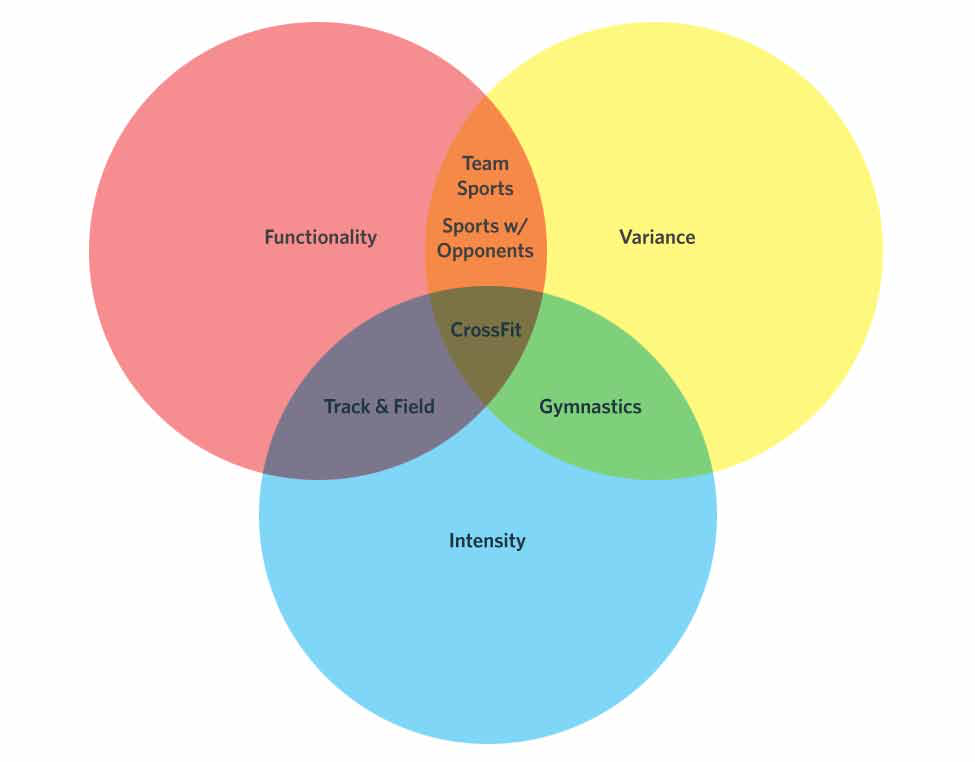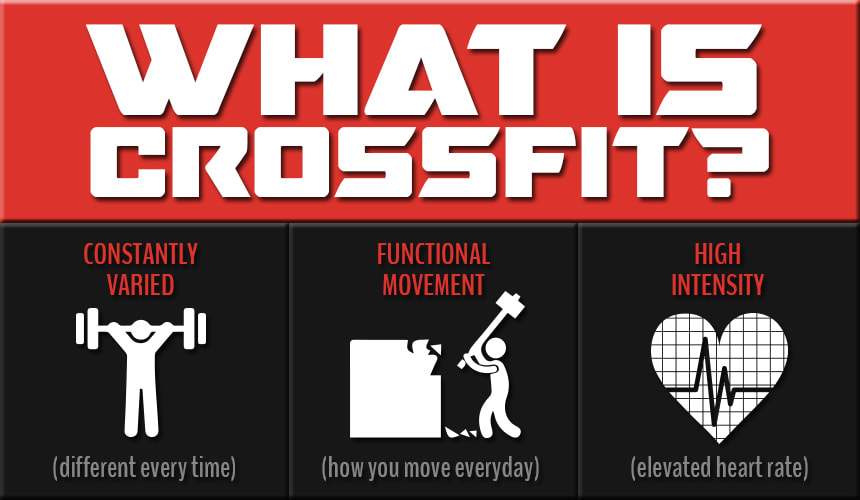|
Venn diagrams show relationships between sets of ideas and they help explain CrossFit’s success. Venn diagrams are a simple and effective visual representation of concepts and their relationships. They work by putting a concept into a circle. Any place where circles intersect shows a relationship between them, resulting in a new idea or concept. The Venn diagram comes out of mathematics and is a powerful tool for exploring ideas and relationships. To understand CrossFit, the three most important concepts are functionality, variance and intensity. These three principles are the foundation of CrossFit. A lot of training programs and sports have one or two of these qualities, but CrossFit is the first that is built around all three. You can’t take one away from a training system and still call it CrossFit. However, being “incomplete” doesn’t make a sport bad. And as we’ll see, at the intersections of two of the three circles, we will find the component sports and activities that make up CrossFit.
In the intersection between variance and intensity, you have sports that push the body to the limits in pursuit of aesthetic and not entirely functional requirements. For example, in gymnastics you have a sport with both variance and intensity. Gymnasts master a wider variety of movements than any other athlete. And it has intensity, because of the incredible strength, flexibility and coordination required. What it lacks is functionality. As gymnastics becomes more and more advanced, it has to move toward greater complexity. What they do on a pommel horse is amazing, but it doesn’t resemble anything you will ever do in real life. A double-twisting double back flip is the least efficient way I can think of to move 15m across the floor. For every flip or twist you remove, you will find a more efficient way to move across a floor. If you keep reducing, you are left with running, which is the most efficient way to move across the floor. Bodybuilding is another example that fits into this intersection. Even though it has almost nothing in common with gymnastics, they are both judged on aesthetic criteria. Bodybuilders tend to do a huge variety of exercises because they have to hit each muscle individually. However, the goal is to create larger muscles as opposed to power output. They use non-functional movements to meet this end. But bodybuilding has intensity—so much, in fact, that bodybuilders often have to use steroids in order to recover from their workouts. Gymnasts focus on movement and bodybuilders focus on muscles. Even though they fall under the same intersection in our diagram, the results the sports produce couldn’t be more different. If you look at the intersection of functionality and intensity, we see a group of relatively simple sports (or events), where the objective is to do something as fast, as heavy or as many times as possible. Track and field is a great example. A 100-meter sprinter has only one thing in the world he needs to do well. And sprinting is functional and intense. Regardless of its short duration, it is pushing the human body to its limit, and the power output is astonishing. Sprinting is also the most functional way to travel 100 meters in a straight line. There are no flips or twists. You can’t remove anything to make it simpler or more efficient. What is lacking is variance. Even a decathlete has a relatively limited variety of skills to learn, and on game day he knows that he will do those same movements and in the same order every time. Eight of the 10 decathlon events last fewer than 15 seconds. One lasts less than a minute, and the other lasts five minutes or less. Even the most varied event within track and field is still somewhat confined in terms of movements and energy systems used. At the intersection of functionality and variance, we have team sports, ball sports and other competitive games. Almost all modern-day sports have their roots in preparing men for war. Most sports comprise functional movements, such as running, jumping, throwing, pushing, etc. And we have variance, because of the variety of movements presented within each sport and how the conditions change from one game to the next. High jumpers know exactly where the bar is going to be. They carefully measure steps and approach each jump the same way. They know exactly what they have to do on game day. But sports don’t follow a script. An athlete must adapt at all times based on what his opponents and teammates are doing. So, we have variance. What we don’t have is absolute 100 percent intensity. When you have to adapt to externalities, you cannot push your body to its limit. You can never be pushed as hard on the field as you can in drills or workouts. Playing a sport doesn’t mean you are a slacker, of course. It just means that in absolute measures of intensity, such as power output, you will never reach your limit during play. This is the difference between effort and intensity. At the intersection of all three circles, we have CrossFit. It is a fitness program consisting of functional movements. These movements are picked from the activities mentioned above. We have intensity, because functional movements drive power output more effectively than anything else. And we have variance, because CrossFit requires an athlete to be competent in so many different domains—including endless combinations of movements, durations and loads. Plus, you don’t even know what the next workout will be! If one of these three components is missing, then you don’t have a complete fitness program. This is why all athletes do extra training off the field to supplement what is missing in their sports. It’s also why people who have to deal with functionality, variance and intensity in real life or in their sport, such as soldiers and MMA fighters, have embraced CrossFit. It is because of the combined power of functionality, variance and intensity that CrossFit is the most complete fitness program anywhere. - CrossFit Journal December 2010
0 Comments
Leave a Reply. |
AuthorCrossFit Pretoria Archives
April 2023
Categories
All
|



 RSS Feed
RSS Feed
